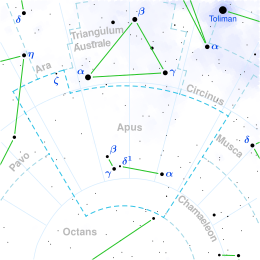| Observation data Epoch J2000.0 Equinox J2000.0 (ICRS) | |
|---|---|
| Constellation | Apus |
| Right ascension | 15h 39m 18.39712s[1] |
| Declination | −77° 55′ 04.8196″[1] |
| Apparent magnitude (V) | 6.18±0.01[2] |
| Characteristics | |
| Evolutionary stage | horizontal branch[3] |
| Spectral type | K2.5 IIIb CN1.5 Ba+0.5[4] |
| U−B color index | +1.36[5] |
| B−V color index | +1.21[5] |
| Astrometry | |
| Radial velocity (Rv) | +13.1[6] km/s |
| Proper motion (μ) | RA: −79.376 mas/yr[1] Dec.: −130.969 mas/yr[1] |
| Parallax (π) | 9.0832 ± 0.0204 mas[1] |
| Distance | 359.1 ± 0.8 ly (110.1 ± 0.2 pc) |
| Absolute magnitude (MV) | +1.21[7] |
| Details | |
| Mass | 1.59[8] M☉ |
| Radius | 13±0.7[9] R☉ |
| Luminosity | 52.5+2.5 −2.4[10] L☉ |
| Surface gravity (log g) | 2.71[8] cgs |
| Temperature | 4,672±100[11] K |
| Metallicity [Fe/H] | −0.04[8] dex |
| Rotational velocity (v sin i) | 5.2±4.3[12] km/s |
| Age | 2.78+0.37 −0.52[1] Gyr |
| Other designations | |
| Database references | |
| SIMBAD | data |
HD 138289, also known as HR 5757, is a probable spectroscopic binary[12] located in the constellation Apus, the bird-of-paradise. It has an apparent magnitude of 6.18,[2] placing it near the limit for naked eye. Gaia DR3 parallax measurements place the object 359 light years away[1] and it is currently receding with a heliocentric radial velocity of 13.1 km/s.[6] At its current distance, HD 138289's brightness is diminished by 0.25 magnitudes due to extinction from interstellar dust.[15] It has an absolute magnitude of +1.21.[7]
The visible component has a stellar classification of K2.5 IIIb CN1.5 Ba+0.5,[4] indicating that it is a red giant with an anomalous overabundance of cyano radicals in its spectrum. The IIIb luminosity class indicates that it is a lower luminosity giant star. The Ba+0.5 suffix states that it is a mild barium star, whose barium abundance might have come from a hidden white dwarf companion. HD 138289 is estimated to be 2.8 billion years old,[1] enough time for it to cool and expand to 13 times the radius of the Sun.[9] It is now on the horizontal branch,[3] fusing helium at its core. At present it has 1.59 times the mass of the Sun and radiates 52.5 times the luminosity of the Sun[10] from its enlarged photosphere at an effective temperature of 4,672 K.[11] HD 138289 has a near solar metallicity and spins modestly with a poorly constrained projected rotational velocity of 5.2 km/s.[12]
- ^ a b c d e f g Cite error: The named reference
GaiaDR3was invoked but never defined (see the help page). - ^ a b Cite error: The named reference
Tycho2000was invoked but never defined (see the help page). - ^ a b Cite error: The named reference
Laney2011was invoked but never defined (see the help page). - ^ a b Cite error: The named reference
Keenan1989was invoked but never defined (see the help page). - ^ a b Cite error: The named reference
Johnson1966was invoked but never defined (see the help page). - ^ a b Cite error: The named reference
Evans1966was invoked but never defined (see the help page). - ^ a b Cite error: The named reference
Anderson2012was invoked but never defined (see the help page). - ^ a b c Cite error: The named reference
Liu2007was invoked but never defined (see the help page). - ^ a b Cite error: The named reference
Kervella2004was invoked but never defined (see the help page). - ^ a b Cite error: The named reference
Charbonnel2020was invoked but never defined (see the help page). - ^ a b Cite error: The named reference
Stassun2019was invoked but never defined (see the help page). - ^ a b c Cite error: The named reference
De Medeiros2014was invoked but never defined (see the help page). - ^ Cite error: The named reference
Gould1879was invoked but never defined (see the help page). - ^ Cite error: The named reference
SIMBADwas invoked but never defined (see the help page). - ^ Cite error: The named reference
Gontcharov2017was invoked but never defined (see the help page).
